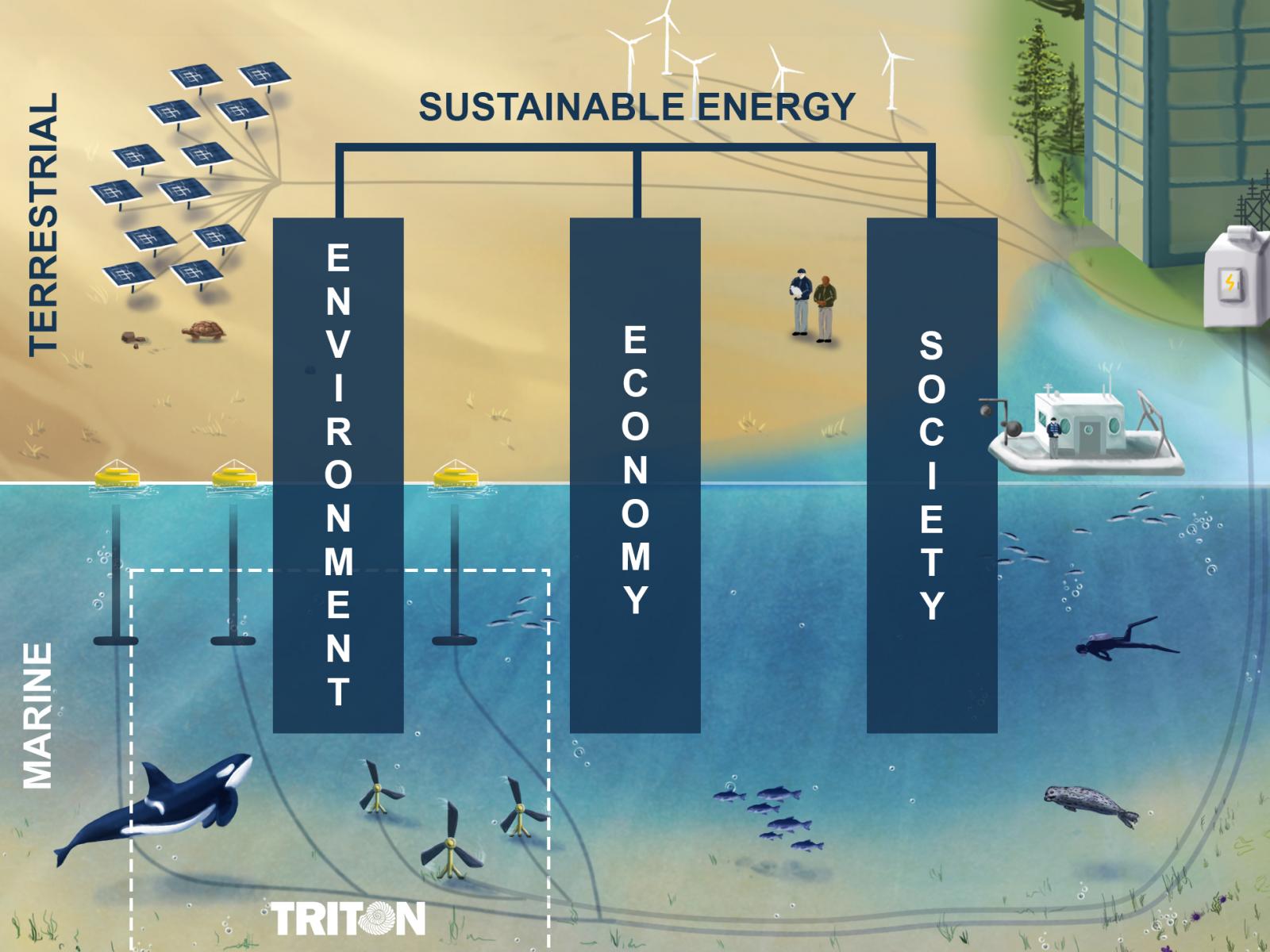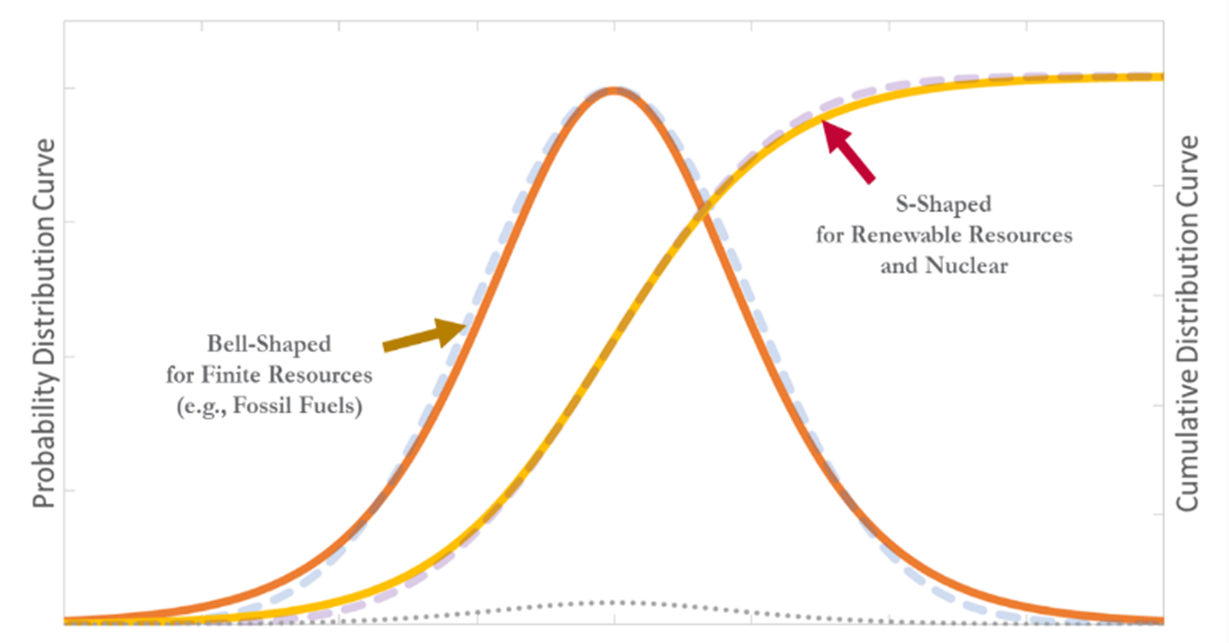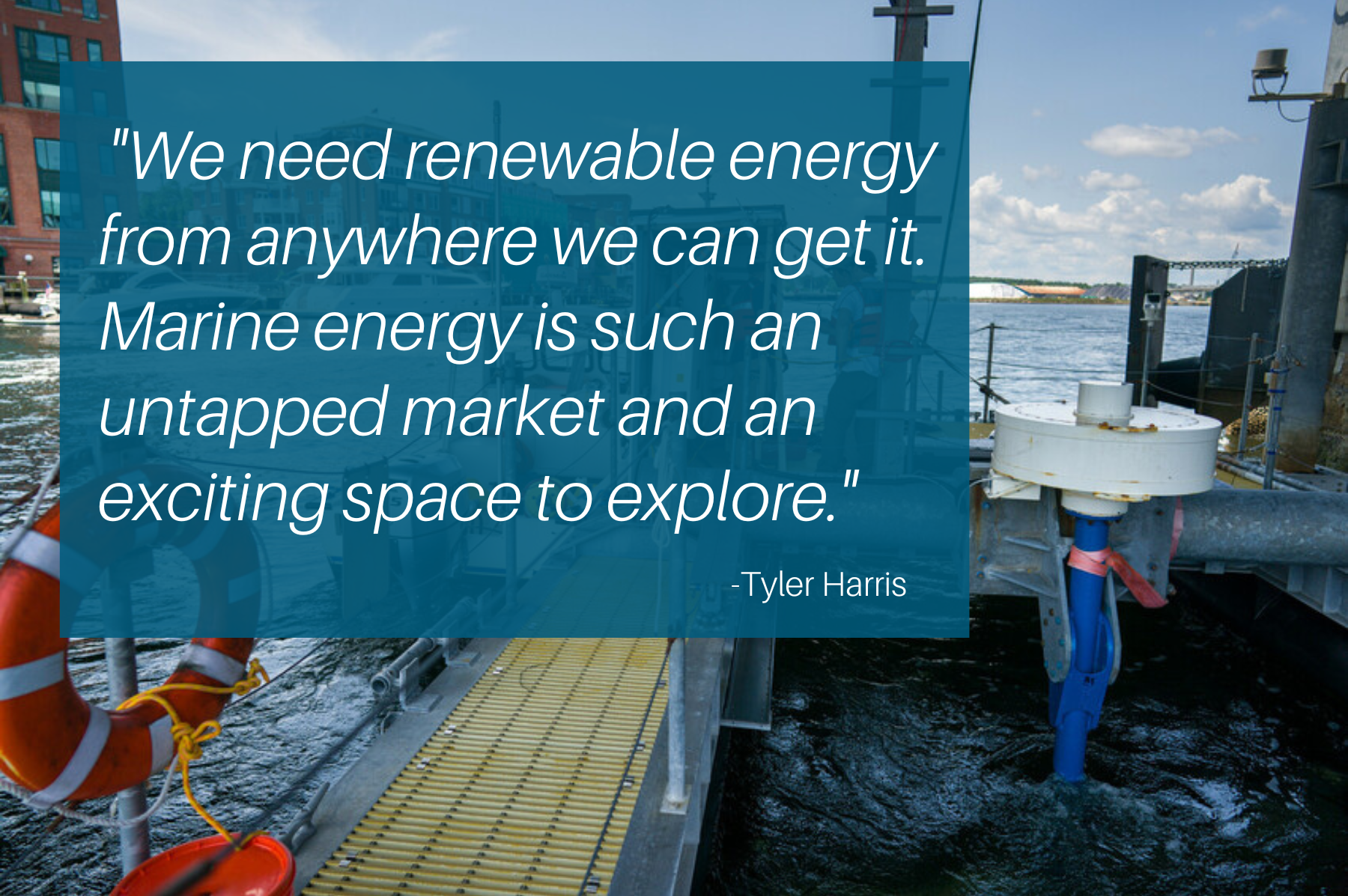Considering the Whole Environment
Discussing sustainability for marine energy with Tyler Harris and Alicia Amerson

The three pillars of sustainability and sustainable energy applied to marine energy from Amerson et al., 2022.
(Illustration by Stephanie King | Pacific Northwest National Laboratory)
What does it mean for energy to truly be sustainable? The goal of developing and refining renewable energy technologies is to move toward a more sustainable future to power human activities. The Triton Initiative, funded by the Department of Energy, Water Power Technologies Office, aims to build knowledge around possible environmental impacts to ensure marine energy causes no unnecessary harm to the ocean’s animals or habitats. However, sustainability extends beyond the direct effects of a marine energy device.
Defining sustainability
Sustainability is the ability to maintain or support a process over time. The concept often refers to the ability of humans and nature to coexist now and in the future while supporting a healthy society, economy, and environment.
Finite fossil fuel resources propelled humankind through the industrial revolution and enabled modernization. Of course, the carbon-emitting properties of fossil fuels are of great concern for the global climate, but these resources are also unsustainable for other reasons. A bell-curve-shaped model is produced when projecting the resource use of fossil fuels—their availability goes up quickly and down quickly, eventually leading to complete depletion over time. While the growth of renewable energy resources does not rise as quickly, it follows an S-curve pattern—the ability to produce energy slowly increases, plateaus once the infrastructure for production is in place, and then continues far into the future. According to the U.S. Energy Information Administration, the nation's energy portfolio comprised 61% of fossil fuels in 2021. To meet the energy demands of today's society and reduce our collective dependence on dwindling resources, we need the development of diverse renewable energy infrastructure to establish a new, sustainable portfolio of energy, which includes marine energy. For this brighter future to be realized, we must first ensure the renewable resources we hope to tap into are sustainable.

Triton plays a valuable role in the advancement of marine energy. The project's research furthers monitoring practices and increases knowledge around the possible environmental effects of marine energy devices to facilitate the necessary permitting to move the industry toward commercialization and deployment. The Triton team recently published a collection of peer-reviewed papers in a special issue of the Journal of Marine Science and Engineering, titled Technology and Methods for Environmental Monitoring of Marine Renewable Energy. This special issue presents results and recommendations from environmental monitoring field tests through the Triton Field Trials campaign. While the special issue predominantly served to disseminate results from field research monitoring collision risk, electromagnetic fields, underwater noise, and changes in habitat, it was also an opportunity to discuss broader impacts, the value of communication, and considerations for sustainability and energy equity.
Because of the novel nature of this special issue, Triton researcher Alicia Amerson saw an opportunity to provide a synthesis article that explored environmental considerations beyond the scope of the Triton Field Trials. The paper, titled "A Summary of Environmental Monitoring Recommendations for Marine Energy Development That Considers Life Cycle Sustainability," provided high-level summaries of the special issue topics and included discussions on spatial and temporal planning considerations for monitoring, communication, and outreach efforts to bolster impact, marine energy sustainability, and life cycle assessment next steps. "It's essential to know what is of great importance to stakeholders in the industry so that these topics can be incorporated as marine energy devices and facilities are completed," says Amerson. "One consideration for marine energy installation is community impact and sustainability."
Introducing these themes into the special issue required specialists in life cycle assessment, equity, and diversity, which inspired collaboration with Pacific Northwest National Laboratory (PNNL) sustainability engineers Tyler Harris and Savannah Michener. Incorporating their unique expertise into Triton's collection of environmental effects research helped connect Triton's science to the broader picture of sustainability. Amerson shares her vision for this publication, explaining that "it serves as an invitation for others to think more holistically in their research, and how to expand collaboration in the spirit of making all renewable energy technologies possible with minimal to no negative impact."
The role of a sustainability engineer

Sustainability engineers help balance and optimize tradeoffs between the impacts and benefits of things like renewable energy development or natural resource management, all to help ensure the wellbeing and welfare of all life on Earth for the near and distant future. As a sustainability engineer, Harris and his team help study and improve the performance of complex, interconnected systems from environmental, economic, and social perspectives.
Harris took a winding road to PNNL, from pursuing music and serving in the Marine Corps to Columbia University, where he focused on environmental science and astronomy, to building the first X-ray satellite telescope. In pursuing a career that would help make a difference in the world, he eventually became a laboratory manager at Arizona State University, where he studied sustainable engineering and life cycle assessments. Harris finished his PhD in civil and environmental engineering at the Colorado School of Mines and found his passion for sustainability modeling and helping find answers to some of the world's most complex and seemingly unsolvable problems. Harris joined PNNL in 2018 and has helped establish sustainability and resilience research capabilities that guide PNNL's many sponsors to solutions for challenges related to energy, national security, biotechnology, water, and the climate nexus.
Harris has always been fascinated by the big picture interactions of humans, societies, and the resources of the universe. His affinity for environmental science and astronomy catalyzed an interest in planetary resource boundaries and energy production trends, which led to research in energy resources and human development. He found in this research that in most cases, the greater the energy use of a society, the more developed that society is in terms of health, wealth, and education. This learning led to further questions about how the world can be developed, the resources it would take to accomplish that development, and how a balance between society, economies, and the environment can be maintained in the process.
Through life cycle assessments and growth curve modeling of resources, Harris helps research projects like Triton understand the broader view. Harris and his team worked with Amerson to conduct a conceptual analysis of current research and future sustainability needs for marine energy. The findings of their literature review helped lay a foundation for valuable future research that connects Triton's research and findings from other studies to conduct holistic impact assessments and model effects of various development and deployment scenarios. The authors explain that a comprehensive life cycle sustainability approach is invaluable to designing and developing marine energy technologies and should be considered as early as possible to avoid overlooked tradeoffs and unintended consequences before full-scale deployment. Triton's research results are part of the proactive efforts needed to fully understand these nascent renewable energy systems' environmental and ecosystem impacts before deployment in our nation's waters.

Harris explains that results from environmental monitoring published in the special issue need to be integrated into existing methods. This will improve future models that can incorporate marine energy into the big energy picture, one that examines environmental, economic, and social impacts, benefits, and tradeoffs. "The bottom line is that energy is vital for human development, and generating it sustainably is critical," says Harris. "We need renewable energy from anywhere we can get it. Marine energy is such an untapped market and an exciting space to explore; there's a lot of possibilities and work that still needs to be done."
While this work identified the next steps for life cycle assessments, it also helped the Triton team identify areas to assess environmental monitoring practices more wholly. Integrating concepts such as timing and spatial distribution of monitoring helps support efficient and impactful research that contributes to sustainability. Triton used the PacWave marine energy test site in Newport, OR, as a case study for incorporating biodiversity, both migratory and native wildlife, as an example for designing future monitoring campaigns. These types of considerations are not only crucial for improving the effectiveness of monitoring at marine energy sites but also for helping build more robust datasets to inform sustainability models. The paper also dives into how to measure the effectiveness of Triton’s recommendations to inform an iterative, participatory process that improves monitoring practices and decision-making based on use cases and lessons learned. Outreach and engagement with key stakeholders and collaborators build the transparency and trust necessary to effectively move the needle on environmental impact studies that serve the industry and energy models.
How do these models work?
The first tenet for quantitatively evaluating and improving the sustainability of systems is the life cycle perspective, which looks at all upstream and downstream processes involved with developing, deploying, and decommissioning a system. These considerations include resource extraction, transportation, infrastructure, manufacturing, use over time, recycling, and the economic repercussions of those activities. Second, assessing sustainability requires an evaluation of the comprehensive suite of impacts on the environment, economies, and societies. Harris explains that this includes climate impacts like global warming potential as well as things like contamination, eutrophication, ozone depletion, acidification, and human health effects. Economic effects include life cycle costs and market responses, and social impacts might include job creation or loss, environmental justice considerations, changes to cultural services, and fair labor practices. Social life cycle studies are currently one of the least explored pieces of sustainability engineering, but are also one of the most important. Evaluating social impacts is essential to ensuring that future energy transitions do not continue historical patterns of injustice and that they work toward the welfare of all.
To conduct a holistic life cycle assessment, researchers require a deep understanding of how each system functions. Subsequently, these studies rely on subject matter experts, background data on emissions and material and energy flows, and current research on impacts. Triton's research contributes to the pools of knowledge that help inform the environmental components. Ideally, these data become integrated into life cycle sustainability assessments of proposed marine energy systems, with the ultimate goal of using empirical environmental monitoring data to compare technologies and deployment scenarios, along with improving system design before full deployment.
"The life cycle assessment, sustainability, equity, and diversity discussion may be surprising to readers," says Amerson. She adds, "perhaps the discussion sparks an innovative change to a marine energy device design, or perhaps a new process is implemented in the manufacturing process to reduce waste or make a product more sustainably." The goal of this paper was to inspire marine energy researchers and industry partners to consider broader impacts and address them when possible. There is an opportunity to think holistically about marine energy devices before they are deployed throughout our coastal waters. The sourcing, development, deployment, and retiring processes all play a role in how truly carbon-reducing and sustainable these technologies are for society, the economy, and the environment.

Thinking bigger
Triton is working on building the knowledge base to better define the unintended environmental impacts associated with marine energy devices and to foster proactive measures to mitigate risks when possible. In the future, Triton could emphasize integrating research results into holistic life cycle impact assessments conducted by the research community, such as universities and national laboratories. Marrying environmental monitoring research like Triton’s with sustainability considerations could help provide design reviews for devices under development from the environmental perspective or identify environmental considerations not apparent to developers that can be proactively addressed to support the advancement of the industry as a whole. The possibilities are abundant. "The next steps are to continue thinking big," says Amerson.
Harris leaves the conversation with what he describes as a “cliché but honest” sentiment: it is important to not make perfect the enemy of good. There will always be tradeoffs when developing solutions to combat climate change, and while it is important to do our due diligence to ensure we mitigate the greatest impacts, getting marine energy devices into the water and generating clean electricity as soon as responsibly possible is needed. We must move forward with the best solutions in order to make the kind of impact the world needs now. Marine energy is part of that need.

Written by Cailene Gunn.
Published: September 14, 2022